For managed IT service providers, standing out online in 2025 isn’t as easy as it used to be. The market is getting more crowded, ad costs are going up, and let’s be honest, explaining what makes your MSP different can be tough. On top of that, many businesses still struggle to show up when potential customers search for things like “IT support services” or “network security services” in their area.
So what’s the better, long-term approach? That’s where SEO comes in. The combo of the right MSP SEO partner and strategy, your business gets found by people who are actively looking for services like cloud solutions, remote IT support, or cybersecurity help. It brings you qualified traffic, not just clicks, and it keeps working even when you’re not running ads.
To figure out what actually works today, we took a close look at 50 MSP websites. We studied how they structure their pages, the type of content they publish, and which keywords they focus on. This gave us a clear picture of what top-performing MSPs are doing to grow through search. In this guide, we’ll break down those insights and show you how to apply the same strategies to grow your visibility and generate more leads.
If you're running a managed IT business, you’ve noticed that getting consistent leads isn't always straightforward. Referrals are great, but they’re not always predictable. Paid ads can work, but they get expensive fast, especially when you’re bidding against big tech companies or national providers.
That’s where SEO steps in, not as a magic trick, but as a reliable way to generate qualified leads without paying for every click.
Here’s why SEO is worth taking seriously in 2025:
What makes SEO even more valuable for MSPs is that it compounds over time. While ads stop the moment your budget runs out, strong SEO content and site structure can keep attracting leads for months or even years.
Now, let’s go over the key strategies you should include in your MSP SEO plan.
One of the first things we focus on in SEO for MSPs is keyword research. It might sound basic, but it’s one of the most important parts of building a strategy that actually brings in leads.
For managed IT businesses, choosing the right keywords means you’re showing up for the exact things potential customers are searching for, not just random tech terms. The goal isn’t to chase broad, vague terms like “IT services”—those are too general and often attract the wrong audience. Instead, go for high-intent keywords that signal someone is close to making a decision.
Think of phrases like “managed IT services for law firms” or “cybersecurity services for small businesses.” These are what we call long-tail keywords. They're more specific, have less competition, and often lead to better-quality traffic.
Even if the search volume is lower, the payoff is bigger. For example, “managed IT services for law firms” only gets around 680 searches per month—but if you’re ranking #1, you could grab nearly 270 of those clicks. And since those searchers are looking for something very specific, there’s a good chance they’re ready to take action.
If your MSP serves a particular area, local keywords are just as important. A term like “managed IT services New York” or “IT support Manhattan” helps you reach businesses that are nearby and already looking for help in your region.
So, before doing anything else, make sure your keyword game is solid. It’s the foundation of everything that comes next.

As we analyzed dozens of MSP websites, we started to notice a clear pattern. No matter the size of the business, whether it’s serving a single city or operating across multiple countries, certain website pages consistently showed up across the board. And for good reason: they’re essential for building trust, improving SEO, and making it easy for potential clients to take action.
Let’s start with the basics. Your homepage, about page, and contact page might seem simple, but they play a big role. The homepage gives people their first impression of your brand. The about page helps them understand who you are and what you stand for. And the contact page is where they go when they’re ready to reach out. These pages create trust—and without them, visitors are more likely to bounce.
The services section is where your SEO can really start pulling its weight. Since most MSPs offer a wide range of solutions such as network security, cloud services, data backup, IT consulting, and more, it’s essential to create a dedicated page for each service. This helps you rank for specific, high-intent searches like “cloud solutions for small businesses” or “IT infrastructure support in Chicago.”
And if you’re targeting certain areas, make sure to localize your service pages. Phrases like “Managed IT Services Los Angeles” aren’t just good for SEO, they tell search engines (and people) exactly where you operate.

Another smart addition? Industry-specific pages. Many top-performing MSPs create tailored content for sectors like healthcare, legal, finance, manufacturing, and law firms. These pages show potential clients that you understand their specific challenges, whether it’s HIPAA compliance or financial data security, and they also help you rank for vertical-specific search terms.
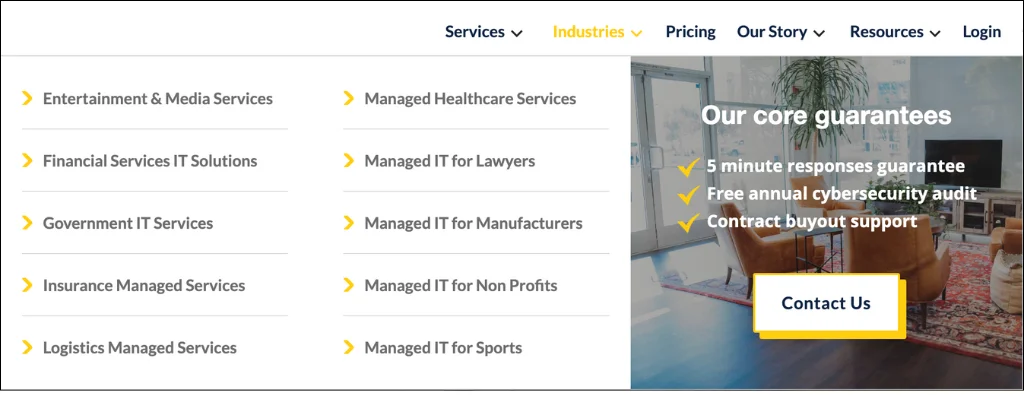
If your MSP serves multiple cities or regions, location pages are a must. These are geo-optimized pages built for the specific areas you work in, even if you don’t have a physical office there. They help you show up in local search results like “IT support in Austin” or “managed services provider in Atlanta.”
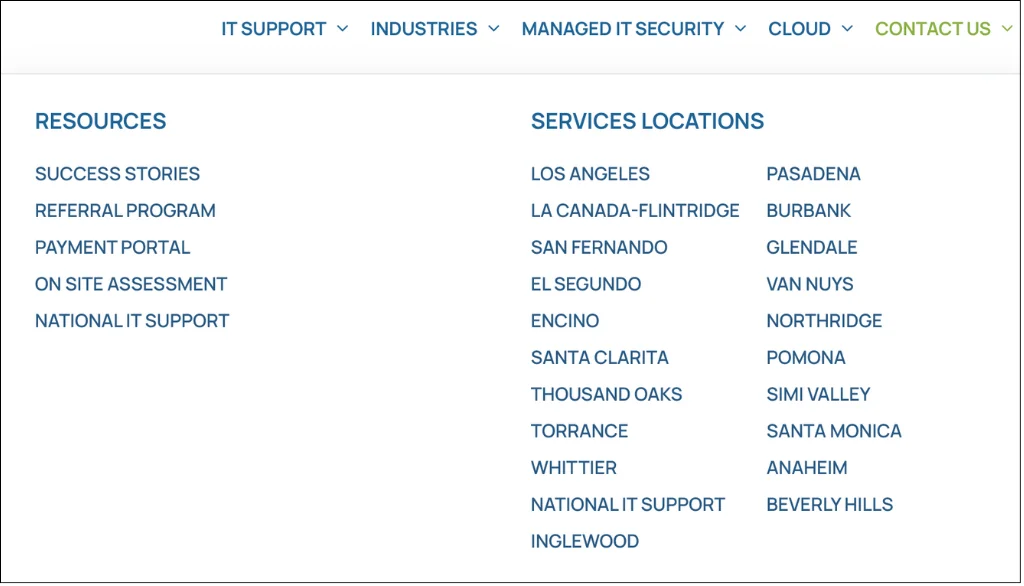
Beyond the essentials, the best MSP websites go further by adding blogs, case studies, whitepapers, guides, or even podcasts. These pages help position your brand as an expert, give visitors a reason to explore your site longer, and support your SEO by building topical authority. Case studies, in particular, can make a big impact. They show real results and build credibility fast.

From what we’ve seen across dozens of managed IT websites, most MSPs tend to fall into one of three categories when it comes to their local SEO approach.
If your MSP operates in just one city or county, your entire website should be built around that specific location. For example, if you're based in Los Angeles and only serve clients in that area, you’ll want every service page optimized with local, high-intent keywords like “managed IT services in Los Angeles” or “Los Angeles network security.”
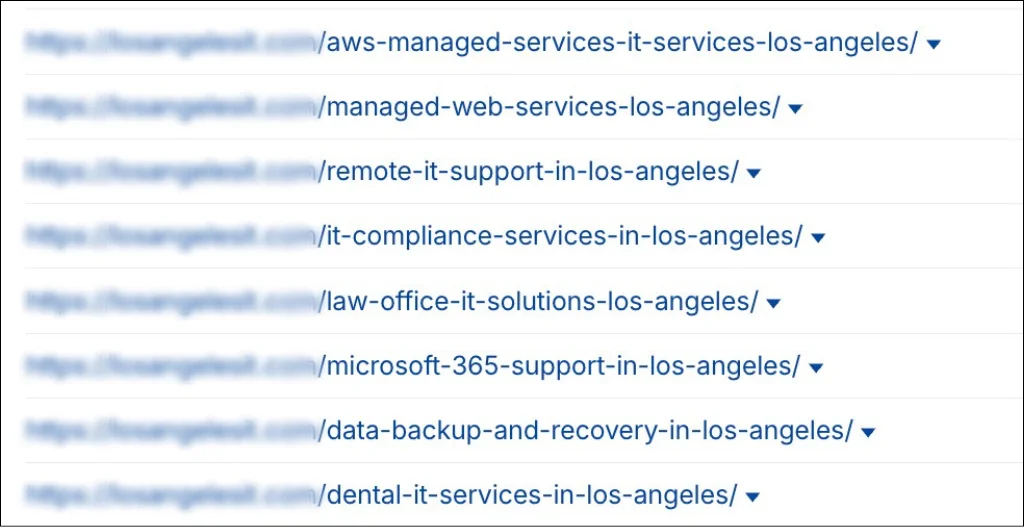
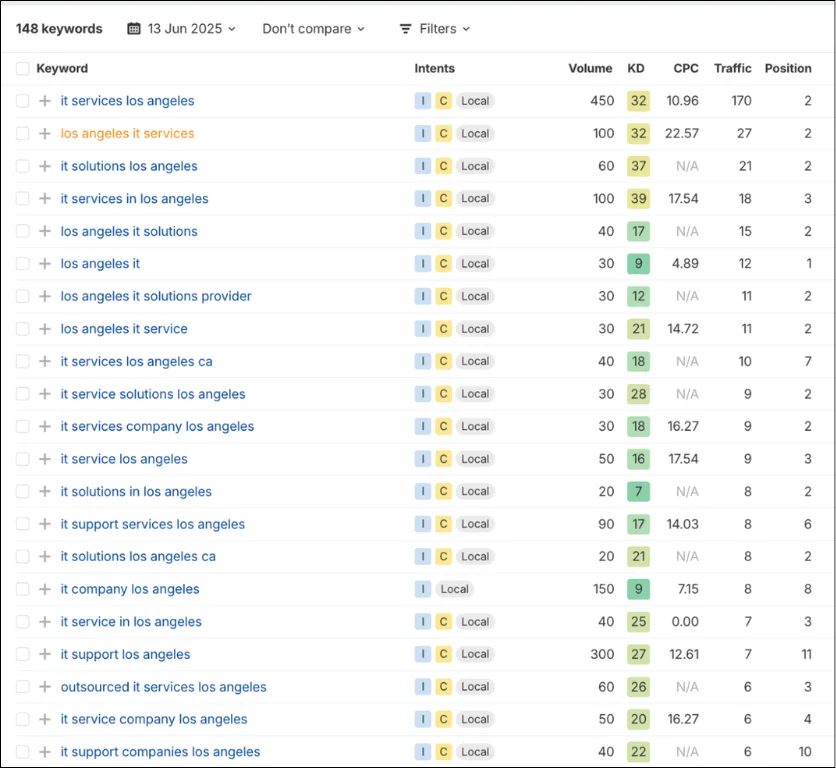
This kind of focused local SEO strategy can work extremely well. By centering your content, URLs, and meta tags around your city, you increase your chances of showing up in local search results and getting found by nearby businesses that are actively looking for IT support.
If staying visible in your local market is a priority, this approach gives you the best shot at ranking high and attracting clients right in your area.

If your MSP serves clients in multiple cities or even nationwide, your SEO strategy should take a broader approach. Instead of tying your main service pages to one location, focus them on high-intent keywords like “IT infrastructure consulting” or “managed IT support services.” This way, you attract businesses looking for help, no matter where they’re based.
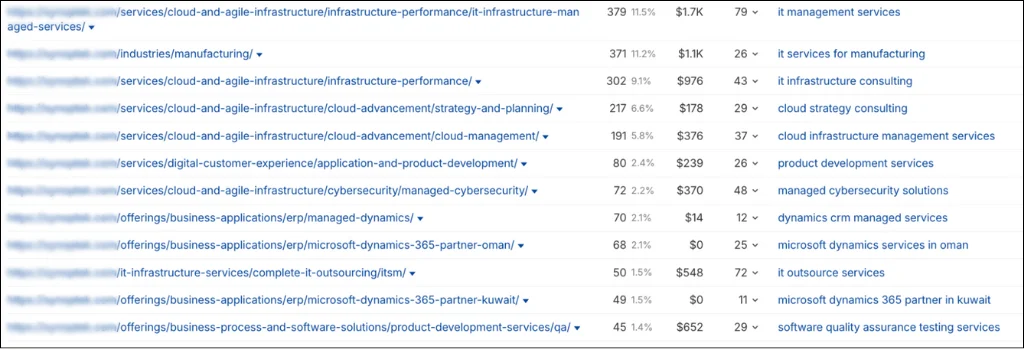
But broad visibility isn’t enough on its own. To show up in local search results, you’ll also want to create dedicated landing pages for each region or city you serve. These pages should be optimized for specific terms like “managed IT services Denver” or “IT support in Charlotte.” Doing this helps you rank locally in multiple areas while still maintaining a strong national presence.
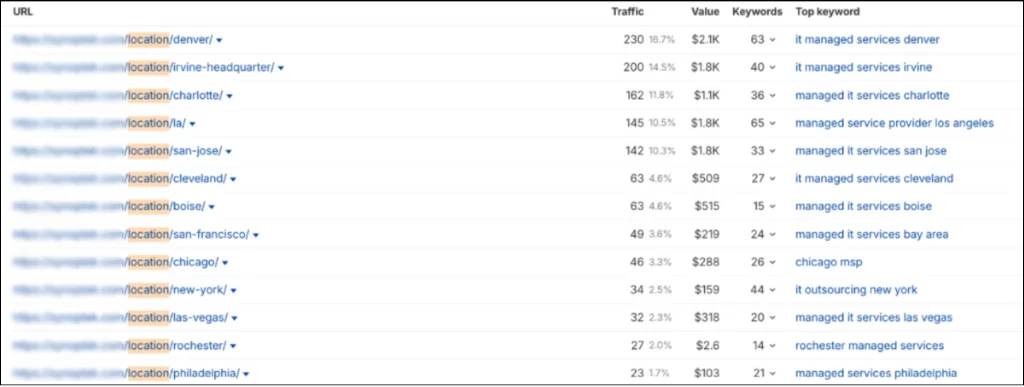
If your MSP operates internationally and provides services across different countries, your SEO approach should reflect that global reach. Instead of tying your main service pages to one location, focus those pages on general service-related keywords like “managed IT support” or “cloud infrastructure management” so they stay relevant across all markets.
To reach local audiences in each country you serve, build dedicated location pages. For example, if you're working with clients in Oman, Kuwait, or Saudi Arabia, you should have separate, optimized pages for each region. These pages help you appear in country-specific search results, even if you don’t have a physical office there.
This approach allows you to maintain a strong global presence while also capturing traffic from people searching for IT support in their local market. So if your business is expanding across borders, make sure your website is built to follow.
If you're a local MSP or even a national provider with offices in different cities, your Google Business Profile (GBP) isn’t just nice to have, it’s a must. When someone types in something like “IT support near me” or “managed services in [your city],” those local listings show up right at the top. And that’s where your profile makes all the difference.
Think of your GBP as your second homepage. It’s often the first thing people see when they search, so make sure everything is up to date—your business name, address, phone number, website link, and business hours. These small details can be the difference between someone clicking on your profile or skipping right past it.
To make your profile work harder for you, here’s what you should focus on:
We’ve seen MSPs jump noticeably in local rankings just by staying active on their profile and engaging with reviews. So if you haven’t updated your GBP in a while, it’s definitely worth carving out a bit of time, it can bring in real results.

For MSPs, creating high-quality content isn’t about churning out articles or stuffing pages with keywords. It’s about offering something useful, content that answers your audience’s questions, shows that you know your stuff, and builds trust along the way. This can include your service pages, blog posts, case studies, and even testimonials from real clients.
To make sure your content actually performs, both in search results and with real people reading it, there are a few things worth paying attention to.
Meta titles and meta descriptions are often the first things someone sees in search, so they need to be clear and relevant.
A good title includes a high-intent keyword and makes the page’s purpose obvious. Something like “Expert Managed IT Services for Small Businesses in Los Angeles” gets straight to the point and tells the reader exactly what they can expect.
Your meta description should briefly support this, think of it as a mini pitch that highlights what’s on the page using natural phrasing and a couple of secondary keywords, such as “IT support for small businesses” or “affordable IT services.”
A solid example might be: “Get reliable managed IT services for small businesses in Los Angeles. Our expert team offers affordable IT support, cloud solutions, and network security.”
Then there’s how you organize your content. Using header tags properly, your H1s, H2s, and H3s, makes a real difference.
Your H1 should always be the main title of the page, while H2s help break your content into sections that are easier to read.
This makes your page more skimmable for users and also helps search engines understand the structure.
For instance, on a service page about IT support, you might use H2s like “We’re the IT Support You Are Looking For” or “The Importance of Choosing a Capable IT Support Provider.” These kinds of headings not only help with SEO, they also keep your message clear and approachable.
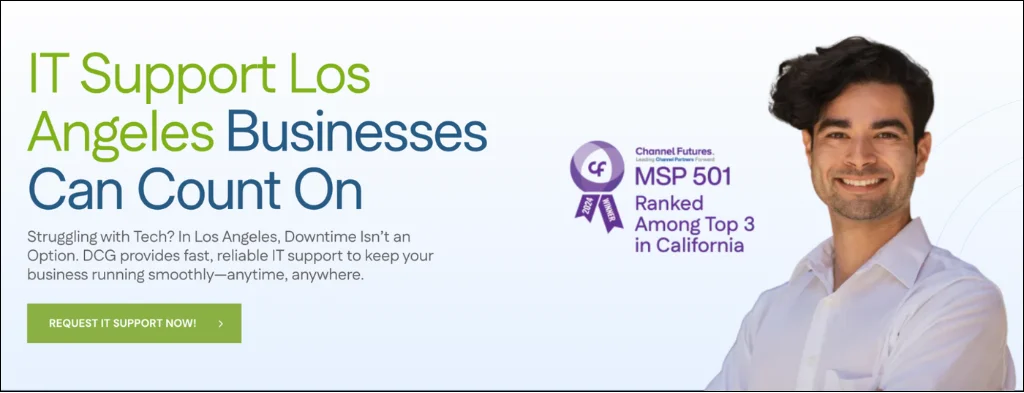
To rank well, it’s critical to focus on E-E-A-T (Experience, Expertise, Authoritativeness, and Trustworthiness) of your content. Google values websites that demonstrate high E-E-A-T, and this can be showcased in your content in several ways:
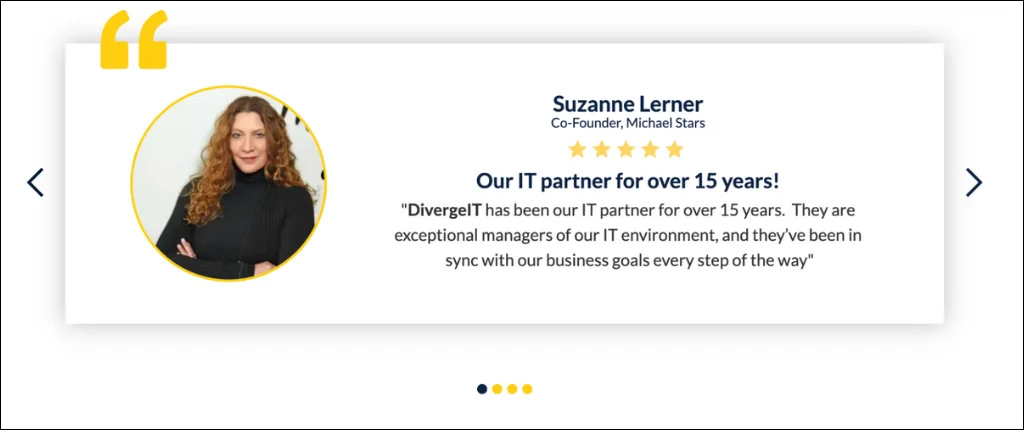
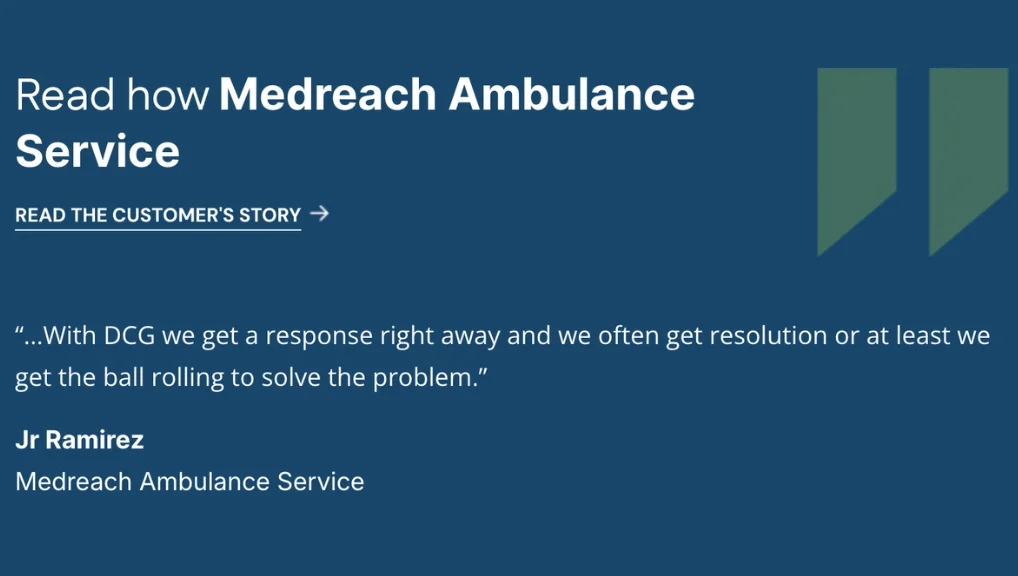



When you’re creating content for your service pages, the goal is to speak directly to your audience and show them how your MSP services can solve their specific problems. Here’s a simple way to structure your service pages:
When creating blog content, your goal should be to share valuable insights that not only solve your audience's problems but also establish your authority in your industry. Here’s how to do it effectively:
Here are some key technical recommendations that can make a significant impact on your MSP website’s SEO performance:
Structured data helps search engines understand your content and present it in rich snippets. For MSPs targeting specific locations, it is recommended to add LocalBusiness schema markup.
Search engines prefer URLs that are clean, easy to read, and clearly tell what the page is about. And for MSPs, this really matters, especially when you're offering a range of services across multiple locations or industries.
Speed matters more than you might think. Google doesn’t like slow-loading websites, and neither do your potential clients. If your MSP website takes too long to load, visitors are more likely to bounce before they even see what you offer. And that hurts your rankings.
Your XML sitemap and robots.txt file help search engines understand how to navigate your MSP website.
Make sure your sitemap includes all key pages, like services, locations, industry-specific content, and blog posts—so nothing important gets overlooked.
At the same time, your robots.txt file should allow search engines to crawl your public pages but skip over things like admin areas or internal dashboards.
These behind-the-scenes tools may be simple, but they make a real difference in how easily your content gets indexed and ranked.
When you're working on building a stronger online presence for your MSP, link building is one of those strategies that quietly does a lot of heavy lifting. The right backlinks don’t just help with rankings, they also make your business look more credible to both search engines and the people searching for IT services.
Link building is not about collecting links just for the sake of it. What really matters is where those links are coming from. A single link from a well-known, trusted site in your industry is worth far more than dozens of low-quality ones.
For MSPs, this means looking for opportunities on websites that cover IT, cybersecurity, or business tech. Let’s say you get mentioned in an article on a respected cybersecurity blog, that kind of link tells Google you know your stuff, and it also puts you in front of an audience that already cares about what you offer.
Guest posting is one of the most effective strategies for building backlinks. When you write valuable, high-quality content for reputable websites, you not only earn a backlink but also position your MSP as a trusted expert in the IT space.
Listing your MSP on reputable directories is a simple yet effective way to acquire valuable backlinks and enhance your local SEO. And when you focus on directories that are actually relevant to the IT space, those links carry even more weight.
One of the most reliable, long-term ways to grow your backlink profile is by building real relationships. When you connect with other businesses, industry experts, or people in your space, those connections can naturally lead to valuable backlinks over time, without forcing it.
After putting in the work, optimizing your MSP website, publishing content, building links, you want to know if it’s all actually paying off. And while traffic is part of the picture, real success comes down to one thing: are the right people finding you and reaching out?
This is where tracking matters. With a few simple tools and the right metrics, you can see what’s working, what needs adjusting, and where to focus next.
Start with Google Analytics and Google Search Console. These will give you insight into how people are landing on your site, what they’re doing once they get there, and how your pages are performing in search.
For MSPs, here’s what’s worth watching:
The point is: don’t just guess. Track what matters, and use that insight to keep improving. SEO isn’t about overnight wins, it’s about steady growth, and knowing where that growth is coming from makes all the difference.
MSP SEO doesn’t stand still. With Google constantly rolling out algorithm updates, and search intent shifting as buyer behavior changes, keeping up can feel like a full-time job. What worked six months ago might not work today, and staying ahead means constantly adjusting your strategy.
But the truth is, tracking every update, analyzing your site’s performance, tweaking technical SEO, and producing content that actually ranks, it’s a lot. And as an MSP, your focus should be on supporting your clients, not chasing search engine changes.
That’s where Loopex Digital comes in. We’re an SEO agency that specializes in helping MSPs build strategies that evolve with the industry. From optimizing technical performance and earning high-quality backlinks to creating location-targeted content that speaks to your audience, we handle it.
If you’re not sure how to keep your SEO efforts current, we’ve got you covered. We'll help you adapt, stay visible, and keep your MSP website working as hard as you do.
Our blog covers a combination of industry trends and professional insights from behind-the-scenes experiences. We provide weekly updates on link building, content marketing, on-site and technical SEO, and more! Sign up for our newsletter and join our LinkedIn to be on top of industry trends!
